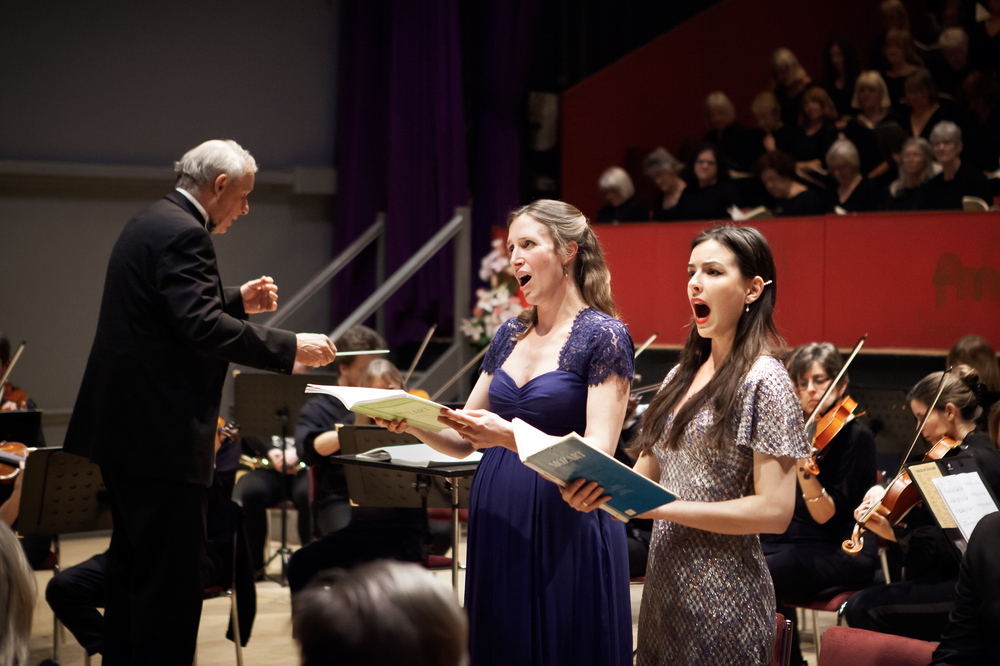A capacity audience was treated to an uplifting all-Mozart programme on 16th March conducted by Festival President Jonathan Willcocks standing in for an indisposed Paul Spicer.
From the revolutionary opening bar of the much-loved Symphony No.40 in G minor, Mozart’s musical ingenuity, ground-breaking orchestration and effortless gift for melody were clearly in evidence. Southern Pro Musica, led energetically by an outstanding Sophie Langdon, delivered a top quality performance and were later joined by the Festival Chorus on excellent form for a thrilling C Minor Mass.
Mozart’s Symphony No.40 is full of light and shade, syncopation and drama, and is one of only two symphonies he composed in the minor key. It reflects Mozart’s interest in the artistic movement Sturm und Drang in which darker and more intense emotion were highlighted, although this piece is also marked by exquisite lyricism and playfulness.
SPM played with all the elegance and passion demanded by the piece. Particularly noteworthy were the delicate but clearly delineated woodwind solos for flute, oboe, clarinet and bassoon. The audience responded visibly to the famous and memorable melodies, particularly in the lilting Andante slow movement in E flat major and the lively, well characterised third movement Minuet and Trio.
Undoubted highlight of the evening, however, was Mozart’s great C Minor Mass. Left unfinished at his death (like the Requiem), some critics have suggested that even in its unfinished state this work on a par with Bach’s B Minor Mass in terms of its magisterial complexity and profound exploration of the human condition. The composition spans a wide stylistic gamut: from demanding counterpoint to some of the most glorious – and operatic – melodies Mozart ever wrote. Why the work was unfinished remains a mystery.
Sofia Ticciati, on her third visit to the Festival, had spell-binding stage presence and sang with a radiant, golden tone. Her performance of the famous Et Incarnatus Est was fluid and beautifully expressive, and the audience was hushed in awe listening to her totally professional technical and artistic control of her famous aria. Clara Orif, second soprano, was lighter in tone but complemented Sofia during the soprano duets and ensemble sections. They were joined by tenor Henry Ross and bass Giles White to complete the outstanding quartet of soloists.
Jonathan Willcocks brought out the very best of the Festival Chorus which navigated the extremely complex counterpoint and rhythmic challenges of the Credo with aplomb and confidence. Diction was clear despite the sometimes difficult underlay of the words.
The second choral concert on 23rd March presented a programme of all English music. First up was the well-known Serenade for Strings by Elgar conducted by Philip Daish-Handy. The strings of Nova Foresta Classical Players, performing at the Festival for the first time, blended into a quintessentially English sound-world of elegy and bucolic nostalgia, clearly relished by the conductor and players.
In a similar idiom, John Ireland’s Downland Suite reflects the composer’s love of the English countryside, particularly the South Downs, and also deployed a string orchestra.
The choral element of the evening was firstly a lesser-known work by George Dyson, Hierusalem. Scored unusually for solo soprano, chorus, string orchestra, harp and organ, the piece sets a text found in Lyra Sacra, an anthology of religious verse published in 1903, derived ultimately in part from a translation of a Latin lyric by St. Augustine. Milly Forrest sang the demanding text with assurance and power, and the chorus rose to the challenge of the lyrical but adventurous harmonic twists and turns and complex rhythms of the score. Giles White conducted.
Also under Giles’ baton, the orchestra and chorus performed John Rutter’s Magnificat in the second half. The Magnificat is an outpouring of praise, joy and trust in God ascribed by St Luke to the Virgin Mary on learning that she is to give birth to Christ. Rutter’s characteristic catchy melodies, up-beat style and idiomatic use of percussion were evidently relished by chorus and orchestra alike and the evening ended on an elated note.
Sarah Hard
